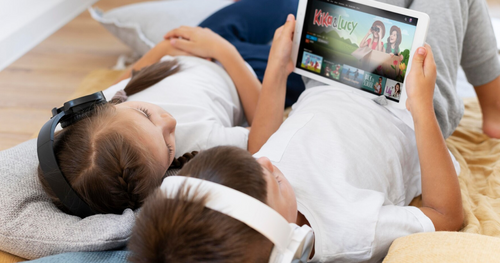There is a common misconception that flipped classrooms and flipped learning are interchangeable terms, however, this is not the case. A flipped classroom can lead to flipped learning, but it's not a guarantee. A flipped classroom is a teaching method that reverses traditional classroom teaching by encouraging students to learn course materials outside the classroom. Flipped learning is a holistic educational approach that emphasises creating a student-centered learning environment in which teachers use a variety of strategies to engage and motivate learners.
Therefore, to help teachers make English lessons more effective and engaging, at AllRight.com you can use a range of materials and resources, including those related to flipped classrooms.
Flipping a class is one method that teachers can use to promote flipped learning. However, to engage in flipped learning, teachers need to incorporate the four pillars - ‘flexible environment, learning culture, intentional content, and professional educator’ into their teaching approach.
The flexible environment pillar involves designing adaptable spaces where students can choose their preferred learning time and location. Teachers who adopt the flipped learning approach must be open to flexible student deadlines and assessments for learning. A flexible learning environment encourages students to take more responsibility for their learning and to manage their time effectively.
The learning culture pillar shifts the focus from teacher-centered to learner-centered. In a flipped classroom, students take an active role in knowledge construction by engaging in and assessing their learning in ways that are personally significant to them. Teachers need to create an environment that fosters engaging learning experiences, encourages critical thinking, and promotes collaboration among students.
The intentional content pillar involves assessing what topics need to be taught, and what resources students should investigate independently. Flipped learning encourages educators to utilise technology to help students develop their conceptual comprehension and procedural expertise. By using technology, teachers can provide a range of learning materials, including videos, podcasts, and interactive activities to help students learn at their own pace.
The professional educator pillar emphasises the importance of a teacher's role in a flipped classroom. While a flipped classroom offers more flexibility, the teacher's role is heightened and more challenging than in a conventional classroom. Teachers must constantly monitor their students' progress, offer real-time feedback, and evaluate their performance. Professional educators must be introspective in their teaching approach, as they will be required to collaborate with their peers to enhance their instruction, welcome constructive feedback, and manage controlled disorder in their classrooms.
For more detailed information, check out the Flipped Learning Network. It provides resources, research, and training related to flipped learning. Their website includes articles, videos, and other resources for teachers, students, and parents.
Benefits of Flipped Classrooms
The flipped classroom model offers several benefits to both teachers and students. For teachers, it allows them to implement a variety of teaching strategies and spend more time providing feedback and individualised support to students. For students, it provides more opportunities for higher-level learning, encourages responsibility for learning, and increases collaboration among peers.
The flexibility of a flipped classroom allows students to learn at their own pace and take responsibility for their own learning. This type of learning environment encourages critical thinking, problem-solving, and creativity. Students can engage in more meaningful discussions, ask questions, and receive personalised feedback from teachers. Teachers can also offer individualised support to students, assess their learning in real time, and adjust instruction accordingly.
Drawbacks of Flipped Classrooms
Despite its many benefits, the flipped classroom model may not work for all subjects or grade levels. Some students may struggle with the self-directed learning that occurs outside the classroom, and creating and curating high-quality content for students can be time-consuming and may require additional resources.
As well as the aforementioned, the flipped classroom model may also have the following disadvantages. Some students may find the model overwhelming or confusing, and they may struggle to make the transition to a more self-directed learning style. Some students may also miss the structure and routine of traditional classrooms, which can negatively impact their learning.
Implementing a Flipped Classroom
To implement a flipped classroom successfully, teachers must first plan how they will use the class time before looking for resources for students to use at home. Teachers must also create engaging videos or podcasts that clearly explain the content to students and provide opportunities for students to apply concepts in class.
One effective strategy for flipped classrooms is to incorporate active learning activities, peer instruction, collaborative learning, problem-based learning, and discussions or debates. Teachers can also encourage students to work on projects or complete assignments that involve creative problem-solving or critical thinking.
Active Learning:
Active learning is a method of learning that involves students in the learning process. In a flipped classroom, students can apply concepts in class where they can ask peers or instructors for feedback and clarification. Active learning is an effective way to engage students and promote deeper learning.
Peer Instruction:
Peer instruction is another strategy that teachers can use to promote flipped learning. Students can teach each other by explaining concepts or working on small problems. Peer instruction can promote collaboration among students, help students learn from one another, and foster a more supportive learning environment.
Collaborative Learning:
Collaborative learning activities could increase student engagement, enhance student understanding, and promote collective intelligence. In a flipped classroom, teachers can encourage students to work together on projects, share their ideas and experiences, and provide feedback to each other. Collaborative learning can also help students develop critical thinking, communication, and problem-solving skills.
Problem-Based Learning:
Problem-based learning is a teaching approach that engages students in solving real-world problems. In a flipped classroom, teachers can spend class time working on problems that can last for the duration of a semester. Problem-based learning can help students develop critical thinking, creativity, and problem-solving skills. It can also promote collaboration among students, as they work together to find solutions to complex problems.
Discussions or Debates:
Discussions or debates are effective strategies for promoting critical thinking and communication skills. In a flipped classroom, teachers can give students the opportunity to articulate their thoughts on the spot and to develop their arguments in support of their opinions or claims. Teachers can also ask thought-provoking questions that encourage students to think critically about the material.
The Golden Rule of Flipped Classroom
Research in flipped classroom design suggests the following rules can significantly improve student learning outcomes:
- The instructional activities conducted during the class sessions entail a considerable amount of interactive exercises such as quizzes, problem-solving tasks, and other hands-on learning activities that require students to retrieve, apply, and expand their knowledge from the materials studied outside the class. These activities are slightly less challenging than the ones assigned outside the class, yet they directly align with the out-of-class assignments.
- The students are incentivized to participate in the learning process through grading, in-class exercises, and the instructor's expectations to complete the out-of-class work and attend the face-to-face meetings.
- The in-classroom learning environment is highly organized and structured, with a precise plan of what is covered during each minute of the session.
In conclusion, the flipped classroom model offers many benefits to both teachers and students.
However, to achieve the full benefits of flipped learning, teachers must incorporate the four pillars - flexible environment, learning culture, intentional content, and professional educator into their teaching approach.
Teachers must create engaging videos or podcasts and provide opportunities for students to apply concepts in class, in addition to incorporating active learning activities, peer instruction, collaborative learning, problem-based learning, and discussions or debates.
Despite the potential drawbacks of the flipped classroom model, it is an effective approach to teaching that can engage students, promote deeper learning, and provide teachers with more opportunities to provide individualised support and feedback. As technology continues to evolve, the flipped classroom model is likely to become more widespread and more widely used in education.









